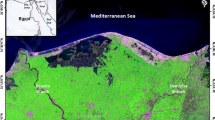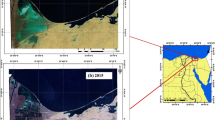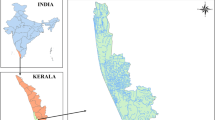Abstract
Ponds, as landscape features, are known to regulate climate. Since ponds proliferate or recede due to natural or anthropogenic factors, a variation of pond numbers implies a variation of their climatic effect. Accordingly, this study investigates the impact of ponds on the local climate of the French Claise watershed. The latter was chosen because it contains a pond dense zone and a pondless zone. This repartition makes the Claise an adequate context to reveal the climatic impact of ponds even in the same landscape. To study the pond-climate effect, the parallel evolution of pond numbers variation and subsequent climatic impact must be tracked. Therefore, the remote sensing-derived Normalized Difference Water Index (NDWI) was extracted from LANDSAT images with different acquisition dates to track changes in pond numbers with time. When compared with a pond map established from aerial photography interpretation, the LANDSAT NDWI map revealed an accuracy of 85.74% for pond count and 75% for pond spatial allocation. This validation showed that NDWI is suitable for mapping the proliferation of ponds through time. In order to study the parallel evolution of the climatic effect, the land surface temperature (LST) index was extracted for each LANDSAT map. LST maps revealed that as a result of pond number variation, surface temperatures varied accordingly. A comparison of air temperatures between the ponded zone and pondless zones also revealed that pond zones had lower air temperatures than their direct surroundings. Accordingly, ponds were shown to buffer local microclimates even within the same landscape.












Similar content being viewed by others
References
Avdan, U., & Jovanovska, G. (2016). Algorithm for automated mapping of land surface temperature using LANDSAT 8 satellite data. Journal of Sensors, 1–8.
Benarrous, R. (2009). La Grande Brenne aux périodes préindustrielles ( Indre ) Contribution à l ’ histoire des paysages , des étangs et des relations sociétés / milieux dans une zone humide continentale . Approches historique , archéologique et paléo-environnementale. Université de Paris I - Panthéon Sorbonne.
Berg, M. D., Popescu, S. C., Wilcox, B. P., Angerer, J. P., Rhodes, E. C., Mcalister, J., & Fox, W. E. (2016). Small farm ponds : Overlooked features with important impacts on watershed sediment transport. Journal of the American Water Resources Association, 52(1), 67–76. https://doi.org/10.1111/1752-1688.12369.
Biggs, J., Williams, P., Whitfield, P., Nicolet, P., & Weatherby, A. (2005). 15 years of pond assessment in Britain: Results and lessons learned from the work of pond conservation. Aquatic Conservation: Marine and Freshwater Ecosystems, 15, 693–714.
Bouscasse, H., Defrance, P., Amand, B., Grandmougi, B., Strosser, P., & Beley, Y. (2011). Amélioration des connaissances sur les fonctions et usages des zones humides : évaluation économique sur des sites tests le cas des étangs de la Grande Brenne.
Brown, L., & Young, K. L. (2006). Assessment of three mapping techniques to delineate lakes and ponds in a Canadian High Arctic Wetland Complex. Arctic, 59(3), 283–293.
Carluer, N., Babut, M., Belliard, J., Bernez, I., Burger-Leenhardt, D., Dorioz, J. M., … Leblanc, B. (2016). Expertise scientifique collective sur l’impact cumulé des retenues. Rapport de synthèse. France.
Céréghino, R., Boix, D., Cauchie, H. M., Martens, K., & Oertli, B. (2014). The ecological role of ponds in a changing world. Hydrobiologia, 723(1), 1–6. https://doi.org/10.1007/s10750-013-1719-y.
Dash, P., Göttsche, F. M., Olesen, F. S., & Fischer, H. (2002). Land surface temperature and emissivity estimation from passive sensor data: Theory and practice-current trends. International Journal of Remote Sensing, 23, 2563–2594.
Dauphin, P., Mansons, J., Pellé, B., Airault, V., Trotignon, J., Boyer, P., … Issa, N. (2012). Document d’objectifs des sites Natura 2000 FR2410003 “Brenne” et FR2400534 “Grande Brenne.”
Downing, J. A. (2010). Emerging global role of small lakes and ponds : Little things mean a lot. Limnetica, 29(1), 9–24.
Downing, J. A., Prairie, Y. T., Cole, J. J., Duarte, C. M., Tranvik, L. J., Striegl, R. G., et al. (2006). The global abundance and size distribution of lakes, ponds, and impoundments. Limnology and Oceanography, 51(5), 2388–2397.
Du, Y., Zhang, Y., Ling, F., Wang, Q., Li, W., & Li, X. (2016). Water bodies’ mapping from Sentinel-2 imagery with Modified Normalized Difference Water Index at 10-m spatial resolution produced by sharpening the swir band. Remote Sensing, 8(354), 1–19. https://doi.org/10.3390/rs8040354.
Durand, Y., Brun, E., Mérindol, L., Guyomarc’h, G., Lesaffre, B., & Martin, E. (1993). A meteorological estimation of relevant parameters for snow models. Annals of Glaciology, 18, 65–71.
Ebel, J. D., & Lowe, W. H. (2013). Constructed ponds and small stream habitats: Hypothesized interactions and methods to minimize impacts. Journal of Water Resource and Protection, 05(07), 723–731. https://doi.org/10.4236/jwarp.2013.57073.
Fischer, G., Nachtergaele, F., Prieler, S., Van Velthuizen, H. T., Verelst, L., & Wiberg, D. (2008). Global agro-ecological zones assessment for agriculture (GAEZ 2008). Rome.
Gao, B. (1996). NDWI—A normalized difference water index for remote sensing of vegetation liquid water from space. Remote Sensing of Environment, 58(3), 257–266.
Guichané, R. (1993). L ‘aménagement hydraulique de la Claise tourangelle et de ses affluents du Moyen-Âge à nos jours / Mills on the claise and its tributaries in Indre-et-Loire from the Middle Ages to modern times. Revue Archéologique Du Centre de La France, 32, 109–152.
Hassall, C. (2014). The ecology and biodiversity of urban ponds. Wiley Interdisciplinary Reviews Water, 1(2), 187–206.
Huang, C., Chen, Y., Wu, J., Li, L., & Liu, R. (2015). An evaluation of Suomi NPP-VIIRS data for surface water detection. Remote Sensing Letters, 6(2), 155–164. https://doi.org/10.1080/2150704X.2015.1017664.
Huang, C., Chen, Y., Zhang, S., & Wu, J. (2018). Detecting, extracting, and monitoring surface water from space using optical sensors: A review. Reviews of Geophysics, 56, 333–360. https://doi.org/10.1029/2018RG000598.
Jakovljević, G., Govedarica, M., & Álvarez-Taboada, F. (2019). Waterbody mapping: A comparison of remotely sensed and GIS open data sources. International Journal of Remote Sensing, 1–29. https://doi.org/10.1080/01431161.2018.1538584.
Joly, D., Brossard, T., Cardot, H., Cavailhes, J., Hilal, M., & Wavresky, P. (2010). Les types de climats en France, une construction spatiale - Types of climates on continental France, a spatial construction. Cybergéo : European Journal of Geography, 501, 1–23. Retrieved from http://prodinra.inra.fr/ft?id=%7BDDCC3C34-7355-486A-A7D2-E2509D33DC4F%7D%5Cn. http://cybergeo.revues.org/index23155.html. Accessed 10/10/2019.
Kumar, M., & Padhy, P. (2015). Environmental perspectives of pond ecosystems: Global issues, services and Indian scenarios. Current World Environment: An International Research Journal of Environmental Sciences, 10(3), 848–867. https://doi.org/10.12944/cwe.10.3.16.
Lima, T. A., Beuchle, R., Langner, A., Grecchi, R. C., Griess, V. C., & Achard, F. (2019). Comparing Sentinel-2 MSI and Landsat 8 OLI imagery for monitoring selective logging in the Brazilian Amazon. Remote Sensing, 11(961), 1–21. https://doi.org/10.3390/rs11080922.
Martin, M. A., Ghent, D., Pires, A. C., Göttsche, F. M., Cermak, J., & Remedios, J. J. (2019). Comprehensive in situ validation of five satellite land surface temperature data sets over multiple stations and years. Remote Sensing, 11(5), 1–31. https://doi.org/10.3390/rs11050479.
Mathé, S., & Rey-Valette, H. (2015). Local knowledge of pond fish-farming ecosystem services: Management implications of stakeholders’ perceptions in three different contexts (Brazil, France and Indonesia). Sustainability (Switzerland), 7, 7644–7666. https://doi.org/10.3390/su7067644.
McFeeters, S. K. (1996). The use of the normalized difference water index (NDWI) in the delineation of open water features. International Journal of Remote Sensing, 17, 1425–1432.
McFeeters, S. K. (2013). Using the Normalized Difference Water Index (NDWI) within a geographic information system to detect swimming pools for mosquito abatement: A practical approach. Remote Sensing, 5, 3544–3561.
Miracle, M. R., Oertli, B., Céréghino, R., & Hull, A. (2010). Preface: Conservation of European ponds-current knowledge and future needs. Limnetica, 29(1), 1–8.
Mishra, K., & Prasad, P. R. C. (2015). Automatic extraction of water bodies from Landsat imagery using perceptron model. Journal of Computational Environmental Sciences, 201, 1–9. https://doi.org/10.1155/2015/903465.
Mueller, N., Lewis, A., Roberts, D., Ring, S., Melrose, R., Sixsmith, J., et al. (2016). Water observations from space: Mapping surface water from 25 years of Landsat imagery across Australia. Remote Sensing of Environment, 174, 341–352. https://doi.org/10.1016/j.rse.2015.11.003.
Mujere, N., & Eslamian, S. (2014). Climate change impacts on hydrology and water resources. In S. Eslamian (Ed.), Handbook of engineering hydrology modeling, climate change and variability 2 (pp. 114–125). CRC-Press.
Oertli, B., Joyer, D. A., Catella, E., Juge, R., Cambin, D., & Lachavanne, J. B. (2002). Does size matter? The relationship between pond area and biodiversity. Biological Conservation, 104, 59–70.
Ottinger, M., Clauss, K., & Kuenzer, C. (2017). Large-scale assessment of coastal aquaculture ponds with Sentinel-1 time series data. Remote Sensing, 9(440), 1–23.
Pearson, K. (1985). Notes on regression and inheritance in the case of two parents. Proceedings of the Royal Society of London, 58, 240–242.
Rosset, V., & Oertli, B. (2011). Freshwater biodiversity under climate warming pressure: Identifying the winners and losers in temperate standing waterbodies. Biological Conservation, 144, 2311–2319.
Ryu, J. H., Won, J. S., & Min, K. D. (2002). Waterline extraction from Landsat TM data in a tidal flat a case study in Gomso Bay, Korea. Remote Sensing of Environment, 83, 442–456. https://doi.org/10.1016/S0034-4257(02)00059-7.
SANDRE (2012). Fiche cours d’eau la Claise (L6--0200).
Sathya, P., & Baby Deepa, V. (2017). Analysis of supervised image classification method for satellite images. International Journal of Computer Science Research, 5(2), 16–19.
Shakir, A., Mishra, P. K., Islam, A., & Alam, N. M. (2015). Simulation of water temperature in a small pond using parametric statistical models: Implications of climate warming. Journal of Environmental Engineering, 142(3), 1–14.
Tulbure, M. G., & Broich, M. (2013). Spatiotemporal dynamic of surface water bodies using Landsat time-series data from 1999 to 2011. ISPRS Journal of Photogrammetry and Remote Sensing, 79(May), 44–52. https://doi.org/10.1016/j.isprsjprs.2013.01.010.
Tulbure, M. G., Broich, M., Stehman, S. V., & Kommareddy, A. (2016). Surface water extent dynamics from three decades of seasonally continuous Landsat time series at subcontinental scale in a semi-arid region. Remote Sensing of Environment, 178, 142–157. https://doi.org/10.1016/j.rse.2016.02.034.
USGS (2012). Earth explorer. Sioux Falls.
Verpoorter, C., Kutser, T., Seekell, D. A., & Tranvik, L. J. (2014). A global inventory of lakes based on high-resolution satellite imagery. Geophysical Research Letters, 41(18), 6392–6402. https://doi.org/10.1002/2014GL060641.
Verstraeten, G., & Poesen, J. (2002). Using sediment deposits in small ponds to quantify yield from small catchments : Possibilities and limitations. Earth Surface Processes and Landforms, 27, 1425–1439. https://doi.org/10.1002/esp.439.
Xu, H. (2006). Modification of Normalized Difference Water Index (NDWI) to enhance open water features in remotely sensed imagery. International Journal of Remote Sensing, 27(14), 3025–3033.
Yan, D., Wang, X., Zhu, X., Huang, C., & Li, W. (2017). Analysis of the use of NDWIgreen and NDWIred for inland water mapping in the Yellow River Basin using Landsat-8 OLI imagery. Remote Sensing Letters, 8(10), 996–1005.
Yang, X., Qin, Q., Grussenmeyer, P., & Koehl, M. (2018). Urban surface water body detection with suppressed built-up noise based on water indices from Sentinel-2 MSI imagery. Remote Sensing of Environment, 219, 259–270. https://doi.org/10.1016/j.rse.2018.09.016.
Yu, X., Guo, X., & Wu, Z. (2014). Land surface temperature retrieval from Landsat 8 TIRS—Comparison between radiative transfer equation-based method, split window algorithm and single channel method. Remote Sensing, 6, 9829–9852.
Acknowledgments
The authors would like to thank the Brenne Natural Regional Park for maintenance of weather station data.
Funding
This research is part of a PhD thesis funded by the National Council for Scientific Research-Lebanon (CNRS-L), Agence Universitaire de la Francophonie (AUF), Beirut, Lebanon and the Lebanese University. It is also part of the Dynétangs project funded by the French Centre-Val-de-Loire region. Authors thank the mentioned parties for funding this research.
Author information
Authors and Affiliations
Corresponding author
Ethics declarations
Conflict of interest
The authors declare that they have no conflicts of interest.
Additional information
Publisher’s note
Springer Nature remains neutral with regard to jurisdictional claims in published maps and institutional affiliations.
Rights and permissions
About this article
Cite this article
Al Sayah, M.J., Nedjai, R., Abdallah, C. et al. On the use of remote sensing to map the proliferation of aquaculture ponds and to investigate their effect on local climate, perspectives from the Claise watershed, France. Environ Monit Assess 192, 301 (2020). https://doi.org/10.1007/s10661-020-08250-0
Received:
Accepted:
Published:
DOI: https://doi.org/10.1007/s10661-020-08250-0




